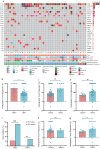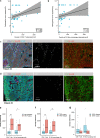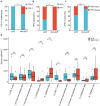Neoadjuvant chemo-immunotherapy with camrelizumab plus nab-paclitaxel and cisplatin in resectable locally advanced squamous cell carcinoma of the head and neck: a pilot phase II trial
- PMID: 38467604
- PMCID: PMC10928200
- DOI: 10.1038/s41467-024-46444-z
Neoadjuvant chemo-immunotherapy with camrelizumab plus nab-paclitaxel and cisplatin in resectable locally advanced squamous cell carcinoma of the head and neck: a pilot phase II trial
Abstract
Neoadjuvant chemoimmunotherapy has emerged as a potential treatment option for resectable head and neck squamous cell carcinoma (HNSCC). In this single-arm phase II trial (NCT04826679), patients with resectable locally advanced HNSCC (T2‒T4, N0‒N3b, M0) received neoadjuvant chemoimmunotherapy with camrelizumab (200 mg), nab-paclitaxel (260 mg/m2), and cisplatin (60 mg/m2) intravenously on day one of each three-week cycle for three cycles. The primary endpoint was the objective response rate (ORR). Secondary endpoints included pathologic complete response (pCR), major pathologic response (MPR), two-year progression-free survival rate, two-year overall survival rate, and toxicities. Here, we report the perioperative outcomes; survival outcomes were not mature at the time of data analysis. Between April 19, 2021 and March 17, 2022, 48 patients were enrolled and received neoadjuvant therapy, 27 of whom proceeded to surgical resection and remaining 21 received non-surgical therapy. The ORR was 89.6% (95% CI: 80.9, 98.2) among 48 patients who completed neoadjuvant therapy. Of the 27 patients who underwent surgery, 17 (63.0%, 95% CI: 44.7, 81.2) achieved a MPR or pCR, with a pCR rate of 55.6% (95% CI: 36.8, 74.3). Treatment-related adverse events of grade 3 or 4 occurred in two patients. This study meets the primary endpoint showing potential efficacy of neoadjuvant camrelizumab plus nab-paclitaxel and cisplatin, with an acceptable safety profile, in patients with resectable locally advanced HNSCC.
© 2024. The Author(s).
Conflict of interest statement
The authors declare no competing interests.
Figures






Similar articles
-
Neoadjuvant Chemoimmunotherapy for the Treatment of Locally Advanced Head and Neck Squamous Cell Carcinoma: A Single-Arm Phase 2 Clinical Trial.Clin Cancer Res. 2022 Aug 2;28(15):3268-3276. doi: 10.1158/1078-0432.CCR-22-0666. Clin Cancer Res. 2022. PMID: 35766967 Free PMC article. Clinical Trial.
-
Neoadjuvant camrelizumab plus chemotherapy for resectable, locally advanced esophageal squamous cell carcinoma (NIC-ESCC2019): A multicenter, phase 2 study.Int J Cancer. 2022 Jul 1;151(1):128-137. doi: 10.1002/ijc.33976. Epub 2022 Mar 21. Int J Cancer. 2022. PMID: 35188268 Clinical Trial.
-
Neoadjuvant with low-dose radiotherapy, tislelizumab, albumin-bound paclitaxel, and cisplatin for resectable locally advanced head and neck squamous cell carcinoma: phase II single-arm trial.Nat Commun. 2025 May 17;16(1):4608. doi: 10.1038/s41467-025-59865-1. Nat Commun. 2025. PMID: 40382318 Free PMC article. Clinical Trial.
-
Neoadjuvant sintilimab combined with chemotherapy in resectable locally advanced non-small cell lung cancer: case series and literature review.World J Surg Oncol. 2023 Sep 26;21(1):304. doi: 10.1186/s12957-023-03194-4. World J Surg Oncol. 2023. PMID: 37749594 Free PMC article. Review.
-
Evaluating the efficacy and safety of different neoadjuvant immunotherapy combinations in locally advanced HNSCC: a systematic review and meta-analysis.Front Immunol. 2024 Aug 29;15:1467306. doi: 10.3389/fimmu.2024.1467306. eCollection 2024. Front Immunol. 2024. PMID: 39267732 Free PMC article.
Cited by
-
Intratumoral and peritumoral radiomics of MRI predicts pathologic complete response to neoadjuvant chemoimmunotherapy in patients with head and neck squamous cell carcinoma.J Immunother Cancer. 2025 Jan 6;13(1):e011189. doi: 10.1136/jitc-2024-011189. J Immunother Cancer. 2025. PMID: 39762084 Free PMC article. No abstract available.
-
The efficacy and safety of the addition of programmed cell death protein 1 inhibitor to preoperative chemotherapy in locoregionally advanced oropharyngeal carcinoma.Transl Cancer Res. 2025 Feb 28;14(2):1401-1414. doi: 10.21037/tcr-2025-202. Epub 2025 Feb 26. Transl Cancer Res. 2025. PMID: 40104753 Free PMC article.
-
Oncologic outcomes following neoadjuvant immunochemotherapy in locally advanced oral squamous cell carcinoma.Front Immunol. 2025 May 8;16:1571285. doi: 10.3389/fimmu.2025.1571285. eCollection 2025. Front Immunol. 2025. PMID: 40406105 Free PMC article.
-
Multi-omics in immunotherapy research for HNSCC: present situation and future perspectives.NPJ Precis Oncol. 2025 Mar 29;9(1):93. doi: 10.1038/s41698-025-00886-w. NPJ Precis Oncol. 2025. PMID: 40158059 Free PMC article. Review.
-
Perioperative the BTLA inhibitor (tifcemalimab) combined with toripalimab and chemotherapy for resectable locally advanced thoracic esophageal squamous cell carcinoma trial (BT-NICE trial): a prospective, single-arm, exploratory study.Front Immunol. 2025 Apr 10;16:1542877. doi: 10.3389/fimmu.2025.1542877. eCollection 2025. Front Immunol. 2025. PMID: 40276504 Free PMC article.
References
-
- Liu J, et al. Improved efficacy of neoadjuvant compared to adjuvant immunotherapy to eradicate metastatic disease. Cancer Discov. 2016;6:1382–1399. doi: 10.1158/2159-8290.CD-16-0577. - DOI - PubMed
Publication types
MeSH terms
Substances
Grants and funding
LinkOut - more resources
Full Text Sources
Medical
Miscellaneous

